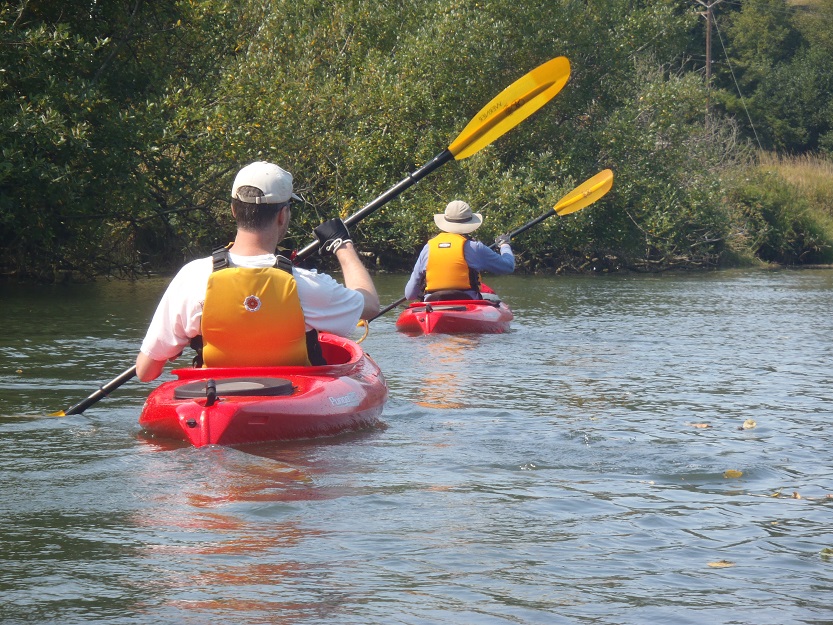Nothing connects you with nature like being on the water. As you drift quietly downriver there is a sense of harmony with your surroundings that can offer moments of pure magic. You might encounter river otters descending silty banks to enter the stream and hunt for fish, or you could spot an American Dipper bobbing in the riffles, searching for aquatic insects and calling out a long, melodious song. Cool river water tumbles over rocks, replenishing clear pools, meandering always towards the ocean. Gravel beds beckon salmon instinctively back from ocean migrations to their spawning grounds, as they have for millennia.
Residents and visitors can experience local waterways via the Tillamook County Water Trail (TCWT). A water trail is defined as a path on a waterway connected through signs, maps, and access points providing a scenic and educational experience for non-motorized users. TCWT encompasses all Tillamook County watersheds and is described through four guidebooks – one for each watershed Nehalem Bay, Tillamook Bay, Netarts Bay, Nestucca Bay & Sand Lake. These guidebooks, which include detailed maps, encourage the quiet exploration and discovery of the ecological, historical, social, and cultural features of Tillamook County from the uplands to the ocean.
Making safety your top priority will ensure that your paddling experience is a positive one. Pleasant weather, favorable tides, and gentle currents can make for an enjoyable trip, but inclement conditions can create serious hazards. River flows can change rapidly with rainfall. The water temperature in Tillamook County is very cold, even in summer months. Tides, currents, wind, and weather should always be factored into your trip planning – check the conditions before you hit the water.
There are many in-water hazards to consider; educate yourself about what these hazards are and learn their locations. Understand that new obstacles can arise at any time, such as log ‘strainers’ left behind from winter floods. Wearing a life jacket is critical. There is always a chance of getting wet, so adequate protective clothing is also essential.
While enjoying the TCWT, be aware of your direct impact on the surrounding area. Your efforts will make a difference for both the environment and other waterway users. Fishing, boating, and hunting are popular in all local watersheds – know the seasons and give ample room for these activities. When observing wildlife, allow adequate space so they are not disturbed. Do not remove rocks, plants, or other native objects, as these create habitat for the multitude of species living along these shores. Public access is a privilege to us all. Out of consideration to private landowners, if you are unsure whether the land is private or public, please stay off.
Nothing connects you with nature like being on the water. As you drift quietly downriver there is a sense of harmony with your surroundings that can offer moments of pure magic. You might encounter river otters descending silty banks to enter the stream and hunt for fish, or you could spot an American Dipper bobbing in the riffles, searching for aquatic insects and calling out a long, melodious song. Cool river water tumbles over rocks, replenishing clear pools, meandering always towards the ocean. Gravel beds beckon salmon instinctively back from ocean migrations to their spawning grounds, as they have for millennia.
Residents and visitors can experience local waterways via the Tillamook County Water Trail (TCWT). A water trail is defined as a path on a waterway connected through signs, maps, and access points providing a scenic and educational experience for non-motorized users. TCWT encompasses all Tillamook County watersheds and is described through four guidebooks – one for each watershed Nehalem Bay, Tillamook Bay, Netarts Bay, Nestucca Bay & Sand Lake. These guidebooks, which include detailed maps, encourage the quiet exploration and discovery of the ecological, historical, social, and cultural features of Tillamook County from the uplands to the ocean.
Making safety your top priority will ensure that your paddling experience is a positive one. Pleasant weather, favorable tides, and gentle currents can make for an enjoyable trip, but inclement conditions can create serious hazards. River flows can change rapidly with rainfall. The water temperature in Tillamook County is very cold, even in summer months. Tides, currents, wind, and weather should always be factored into your trip planning – check the conditions before you hit the water.
There are many in-water hazards to consider; educate yourself about what these hazards are and learn their locations. Understand that new obstacles can arise at any time, such as log ‘strainers’ left behind from winter floods. Wearing a life jacket is critical. There is always a chance of getting wet, so adequate protective clothing is also essential.
While enjoying the TCWT, be aware of your direct impact on the surrounding area. Your efforts will make a difference for both the environment and other waterway users. Fishing, boating, and hunting are popular in all local watersheds – know the seasons and give ample room for these activities. When observing wildlife, allow adequate space so they are not disturbed. Do not remove rocks, plants, or other native objects, as these create habitat for the multitude of species living along these shores. Public access is a privilege to us all. Out of consideration to private landowners, if you are unsure whether the land is private or public, please stay off.
If you are interested in obtaining a guidebook, visit the Tillamook Estuaries Partnership website, www.tbnep.org, and click on the Tillamook County Water Trail link under the Resources menu. You can download pdf versions or request a water-resistant guidebook be mailed to you for a $10 donation (these donation support future reprints). The TCWT aims to help you explore and experience the superior recreational opportunities this area affords with safety, responsibility, and stewardship in mind. So, buckle up your life jacket, grab your guidebook, place your paddle in the water and set out on your next adventure.
Author: Claudine Rehn, Deputy Director, Tillamook Estuaries Partnership (TEP)
Photo Credit: TEP Staff

